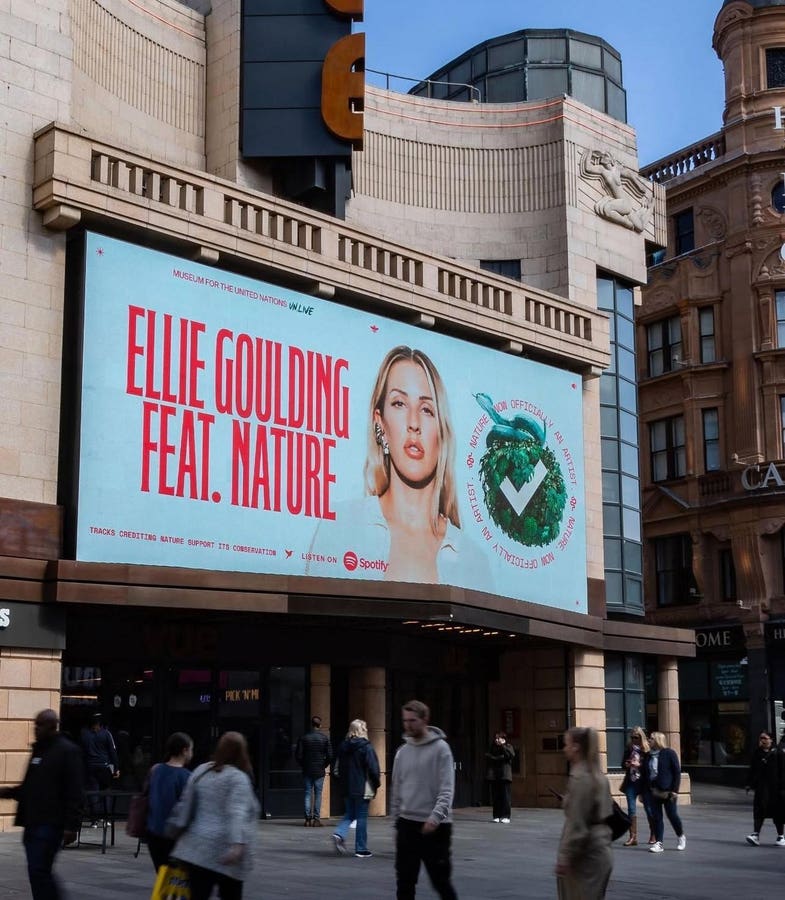We’re living in a world where the sounds of nature are often drowned out by city life and digital noise. But what if, instead of fading into the background, those sounds became the main act?
That’s exactly what the Sounds Right movement is doing—inviting nature to step into the spotlight as a bona fide music artist, and in the process, helping protect the very ecosystems that inspired the tracks. Working with global artists, they’re putting Nature on the main stage at events such as Coachella and Glastonbury – hoping to attracting a younger audience through pop culture.
This Earth Day, over 30 acclaimed artists from across the globe have released new music infused with the sounds of nature: from birdsong and crashing waves to glaciers, moths, antelopes and rainforest wildlife. This unique collection of songs is released as part of Sounds Right, an initiative by the Museum for United Nations – UN Live, that made history last year by launching “Nature” as an official artist on streaming platforms for the first time. More than 10 million people tuned in just on Spotify.
This year’s new tracks feature an eclectic mix of artists, including Grammy winners and rising stars: Breton musician and multi-instrumentalist Yann Tiersen, Indian pop sensation Armaan Malik, electronic powerhouse Steve Angello (Swedish House Mafia), Seattle indie-rocker SYML, and Indian-American singer-songwriter Raveena are among the key contributors. They are joined by artists such as Maejor, Rozzi, George The Poet, Rosa Walton, Penguin Cafe, Madame Gandhi, Franc Moody, and many more.
The musicians and artists come from countries all over the world: UK, US, India, Japan, Colombia, Russia, Denmark, and Argentina. Plus, they’re not from one genre: classical (Evgeny Grinko) to Indian pop (Armaan Malik) to hip-hop (KAM-BU) and techno (Amelie Lens) are included.
From Bogotá’s Biodiversity to the Global Stage
The story of Sounds Right started in Bogotá, Colombia, where a series of workshops in 2019 brought together creatives, musicians, and acoustic ecologists. The goal? To reconnect youth with the biodiversity around them, in a country that sits at the heart of the world’s most diverse ecosystem, the Andes. “We created music featuring nature sounds, and it ended up doing pretty well—even making its way into the Colombian clubbing scene,” says Gabriel Smales, Global Programme Director for Sounds Right. “That’s when we asked: if money’s being generated from nature sound, shouldn’t nature be credited?”
That question sparked a movement. Working with Spotify and creative agency AKQA, the team set out to give nature an official artist profile—complete with album art, streaming royalties, and a place on the world’s biggest music platforms. “AKQA did an amazing job to bring the moment to the public that nature is now officially an artist, and to borrow terminology and visual language from music culture in order to make the concept loud,” Smales says.
Plus it fit the UN’s mandate for the Museum for the United Nations UN Live as well, which is an independent non-profit that should use the power of popular culture to engage everyday people on the missions and values of the UN.
A Debut Year That Resonated
Sounds Right officially launched on April 18 last year at the United Nations, and the response was immediate, Smales says. The campaign was picked up by 460 media outlets, reaching a potential audience of 3.6 billion people. “We had big traction in India, Colombia, and Indonesia, partly because of the artists that were involved, but also I think people were ready for a positive news story and also an action that anyone could take to get involved in this biodiversity crisis.”
Spotify got behind the launch with billboards in New York, Miami, Bogotá, Jakarta, and London. Other streaming giants like Apple Music and Amazon also showed interest. What could have been a controversial move—crediting nature as an artist—was met instead with widespread support. “It’s been less controversial than we thought it might be. I think, as I said, a lot of people got behind what most felt was a positive news story in a pretty difficult news environment,” Smales says.
Letting Artists—and Nature—Lead the Way
What sets Sounds Right apart is its creative freedom. There’s no prescribed formula for how artists should use nature in their music. Some tracks use birdsong or rainfall as a gentle backdrop; others highlight environmental crises with soundscapes of forest fires – an issue that came to light this January in Los Angeles with the wildfires, for example. “Nature’s been inspiring music since music began. We allow the artists complete creative discretion on how they’d like to feature nature in their music,” Smales explains.
This approach has attracted a diverse array of artists, from pop stars to rappers to classical musicians. And the movement is growing: this year, more than 80% of the tracks are brand new, and the share of female artists has jumped from 40% to 50%.
Plus, this music is getting the spotlight at major music festivals. Norwegian singer Aurora played her nature track at the Roskilde Festival on the biggest stage at the festival, the orange stage, in front of 60,000 people. Similarly British artists Cosmo Sheldrake played his track with nature at Glastonbury in the UK last year.
From Streams to Conservation
But Sounds Right isn’t just about making music—it’s about making an impact. Ninety percent of the royalties generated from by Nature streaming go directly to conservation projects, with a focus on Indigenous and community-led initiatives in biodiversity hotspots. “We’ve already committed $225,000 alongside the Biodiversity COP16 in Colombia last year, and we’re primed to commit over $350,000 in 2025, focusing on the Amazon and Congo basins,” Smales says.
The remaining 10% of royalties help cover program costs, though most operational expenses are funded through philanthropy, he clarifies. The initiative has already helped fund projects on the ground, and the hope is that as more people listen, more support will flow to where it’s needed most.
Changing the Tune on Environmental Action
Sounds Right is about more than just streaming numbers. It’s about helping people rediscover their connection to the natural world—whether that’s through listening, recording their own nature sounds, or learning to become “acoustic ecologists.”
As Smales puts it, “The defining crisis of our age is not merely economic or environmental, it’s a crisis of imagination. We think culture has the power to bring that future into focus and to make solidarity with nature feel not just necessary, but doable.”
And just like the best music, the movement is meant to be shared. “We should be meeting people where they are, doing something they already love. Yes, it’s a relatively small contribution, but it’s at no extra cost to themselves. And hopefully, we can build a sense of agency to then inspire those fans to do more,” he adds.
As Sounds Right heads into its second year, it’s clear that nature isn’t just background noise. It’s an artist in its own right—and with every listen, it’s helping tackle conservation through a new perspective and medium.
Read the full article here











